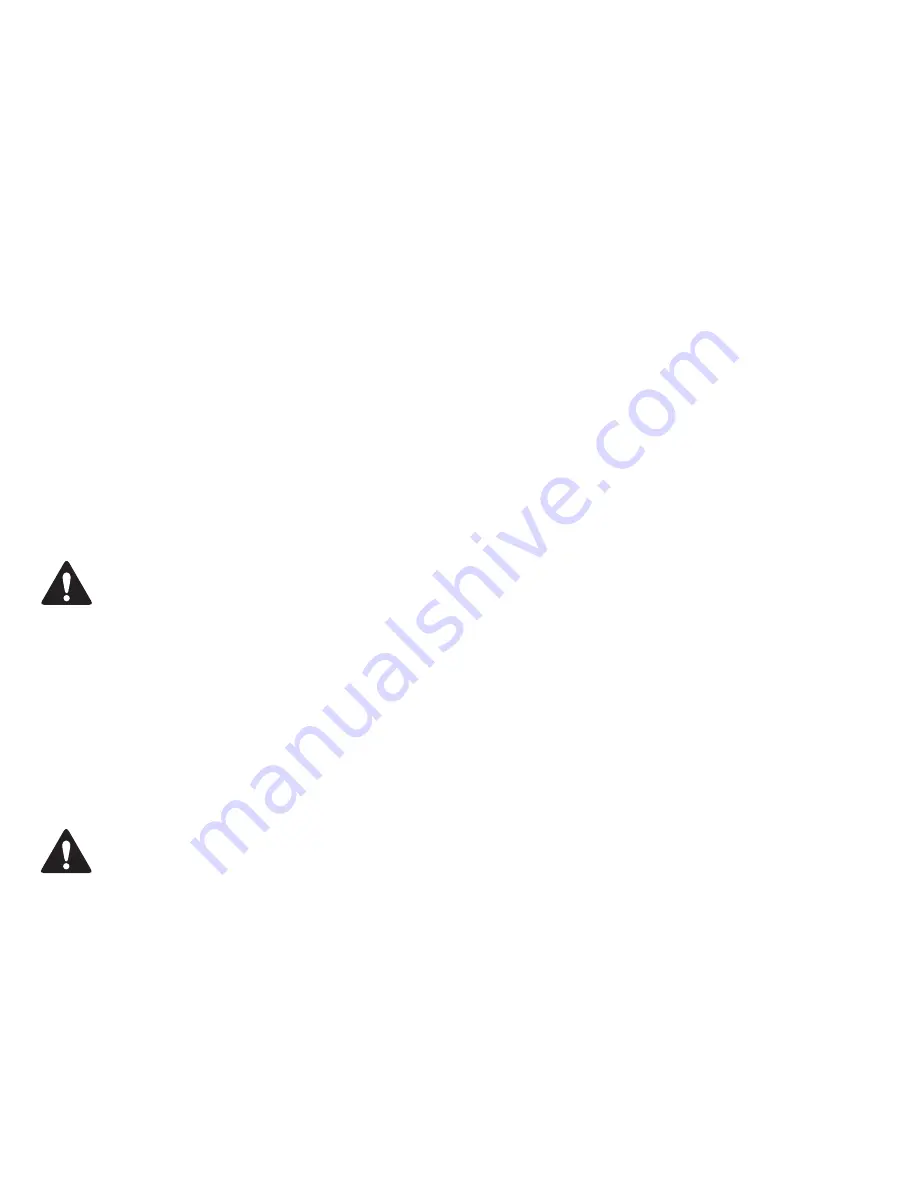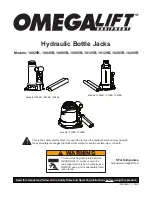
CTJ35NG 3 9/15/16
OWNER/USER RESPONSIBILITY
The owner and/or user must have an understanding of the manufacturer’s operating instructions and warnings before using this jack. Personnel
involved in the use and operation of equipment shall be careful, competent, trained, and qualified in the safe operation of the equipment and its
proper use when servicing motor vehicles and their components. Warning information should be emphasized and understood. If the operator is not
fluent in English, the manufacturer’s instructions and warning shall be read to and discussed with the operator in the operator’s native language by
the purchaser/owner, making sure that the operator comprehends its contents. Owner and/or user must study and maintain for future reference the
manufacturers’ instructions. Owner and/or user is responsible for keeping all warning labels and instruction manuals legible and intact. Replacement
labels and literature are available from the manufacturer.
INSPECTION
Visual inspection should be made before each use of the jack, checking for leaking hydraulic fluid and damaged, loose or missing parts. Each jack must be
inspected by a manufacturer’s repair facility immediately, if subjected to an abnormal load or shock. Any jack which appears to be damaged in any way, is
found to be badly worn, or operates abnormally MUST BE REMOVED FROM SERVICE until necessary repairs are made by a manufacturer’s authorized repair
facility. It is recommended that an annual inspection of the jack be made by a manufacturer’s authorized repair facility and that any defective parts, decals or
warning labels be replaced with manufacturer’s specified parts. A list of authorized repair facilities is available from the manufacturer.
SETUP
Please refer to the exploded view drawing on page 6 in this manual in order to identify parts:
1. Remove the 2-piece handle from box. Insert narrow portion of top section (#18) into bottom section (#19) and secure with handle button (#16).
2. Grease the inside of the handle socket (#21) and remove the handle set screw (#20) from the handle socket (#21). Insert the handle all the way
in the handle socket (#21) until it engages the universal joint assembly (#26). Secure the handle to the handle socket (#21) with the handle set
screw (#20).
3. Air may become trapped in the hydraulic system during shipping and handling. Trapped air will affect the pumping performance of the jack.
If this occurs, follow the air purging procedure below:
a) Rotate the handle. in a clockwise direction until tight. Rotate the handle in a counterclockwise direction two complete revolutions.
b) Pump the handle approximately 10-15 complete pump strokes.
c) Rotate the handle in a clockwise direction until tight. Proceed to pump the jack to maximum lift height.
d) Repeat steps "a" through "c" until all air has been purged from the system.
OPERATION
This is the safety alert symbol used for the
OPERATING INSTRUCTIONS
section of this manual to alert you to potential personal injury
hazards. Obey all instructions to avoid possible injury or death.
IMPORTANT:
Before attempting to raise any vehicle, check vehicle service
manual for recommended lifting surfaces.
1.
To raise load:
Turn the handle in a clockwise direction until tight. Position the jack under the load. Proceed to pump the handle in order to raise
the lift arm to the load. As the saddle at the end of the lift arm gets closer to the load, reposition the jack so the saddle will contact the load firmly
and the load is centered on the saddle. Make sure the saddle is correctly positioned. Raise the load to the desired work height. Place jack stands
of appropriate capacity at the vehicle manufacturers's recommended support areas that provide stable support for the raised vehicle.
DO NOT
CRAWL UNDER VEHICLE WHILE LIFTING VEHICLE OR PLACING OR REMOVING THE JACK STANDS!
Once jack stands are positioned, turn
the handle VERY SLOWLY. Lower the load to rest on the jack stands. Inspect the relationship between the jack stands and load to make sure the
setup is stable and safe. If the setup is not stable or safe, follow the preceding steps until corrected.
2.
To lower load:
Follow the procedures mentioned in "To raise load" section of the
OPERATING INSTRUCTIONS
in order to raise the load off the
jack stands. Once the load has cleared the jack stands, remove the stands from under the load and away from the work area. Turn handle very
slowly in a counterclockwise direction until the load is completely lowered to the ground. Once the jack's lifting saddle has cleared the load,
remove the jack from under the load. CAUTION: Keep hands and feet away from the hinge mechanism of the jack.
DO NOT CRAWL UNDER
VEHICLE WHILE LIFTING VEHICLE OR PLACING OR REMOVING THE JACK STANDS!
PREVENTATIVE MAINTENANCE
This is the safety alert symbol used for the PREVENTATIVE MAINTENANCE section of this manual to alert you to potential personal injury hazards.
Obey all instructions to avoid possible injury or death.
1. Always store the jack in a well protected area where it will not be exposed to inclement weather, corrosive vapors, abrasive dust, or any other harmful
elements. The jack must be cleaned of water, snow, sand, grit, oil, grease or other foreign matter before using.
2. The jack must be lubricated periodically in order to prevent premature wearing of parts. A general purpose grease must be applied to all zerk grease
fittings, caster wheels, front axle, elevator arm, handle base pivot bolts, release mechanism and all other bearing surfaces. Worn parts resulting from
inadequate or no lubrication are not eligible for warranty consideration. See page 5 for lubrication instructions.
3. It should not be necessary to refill or top off the reservoir with hydraulic fluid unless there is an external leak. An external leak requires immediate repair
which must be performed in a dirt-free environment by an authorized service center.
IMPORTANT:
In order to prevent seal damage and jack failure, never use alcohol, hydraulic brake fluid or transmission oil in the jack. Use Chevron Hydraulic
Oil AW ISO 32, its equivalent Unocal Unax AW 150 or hydraulic jack oil.
4. Every jack owner is responsible for keeping the jack labels clean and readable. Use a mild soap solution to wash external surfaces of the jack but not
any moving hydraulic components.
5. Inspect the jack before each use. Do not use the jack if any component is cracked, broken, bent, shows sign of damage or leaks hydraulic fluid. Do not
use the jack if it has loose or missing hardware or components, or is modified in any way. Take corrective action before using the jack again.
6. Any hydraulic repairs within the warranty period must be performed by an authorized service center.
























